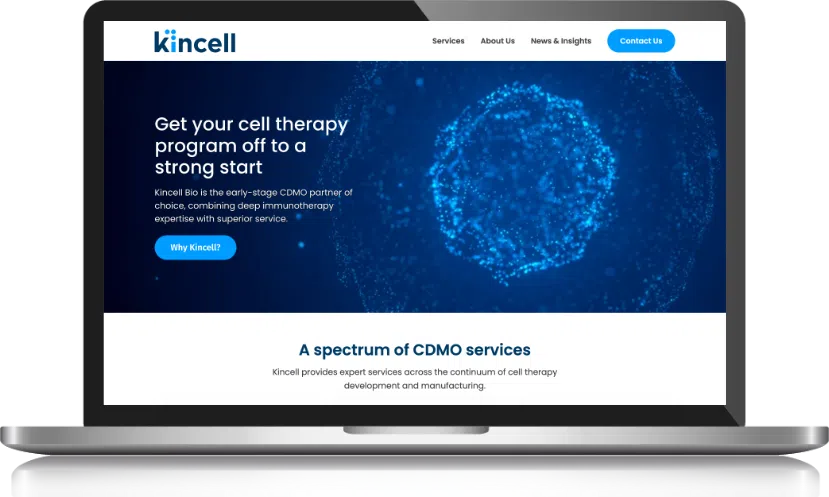Rethinking Website Improvements: A Phased Approach for Life Sciences Marketing Teams
What to fix now, what to plan for later without blowing your budget or waiting for a redesign
In the fast-moving world of life sciences, your website needs to do a lot fast. It must establish trust, explain complex science, attract top talent, and support funding or product launch goals. But for many marketing teams, the website no longer reflects where the company is today. It may be outdated, hard to navigate, missing key messages, or just not something you’re proud to share. And while a full redesign might be ideal, the budget, timing, or internal buy-in simply isn’t there yet.
The good news? You don’t have to overhaul everything at once.
In this blog, we’ll share a phased approach to website improvements that life sciences marketers can use to make strategic progress now without waiting for that “someday” redesign. Whether you’re working with internal resources or an agency partner, these short-term fixes and long-term strategies can help you get unstuck and move forward with confidence.
Step 1: Assess Your Current Website
Start with a candid evaluation of your existing site. This doesn’t require outside help. You and your team know the business best. Ask questions like:
- Is the content accurate and current? (Think clinical stages, leadership bios, messaging.)
- Does the homepage clearly explain who we are and what we do?
- Is the structure intuitive, or does it feel cluttered or disorganized?
- Are users given multiple, clear ways to engage beyond a contact form?
- How does the site perform on mobile and different browsers?
- Can we be found online for key scientific terms or industry categories?
- What does Google Analytics tell us about user behavior and traffic flow?
This initial audit creates a baseline. It also helps shift your team’s mindset from “we need a whole new website” to “what’s working, what’s not, and what can we improve now?”
Step 2: Bring Your Team Into the Conversation
Your website isn’t just a marketing asset. It represents the entire organization. That’s why input from across departments is so valuable.
Meet with colleagues from marketing, research, business development, HR, and leadership. Ask:
- What would make the website more useful or impactful for your team?
- What are the most common questions or misconceptions you hear?
- Are there competitor websites you admire? Why?
- What do you think the website should accomplish in the next 6 to 12 months?
If someone says, “the website isn’t my area,” ask what success would look like for them to gather some valuable insights.
This dialogue also helps surface misalignments early and turns future critics into collaborators.
Quick Wins You Can Make Now (Without Waiting for a Website Redesign)
Once you’ve assessed the site and gathered input, start with low-effort, high-impact improvements that can be tackled quickly. These can often be handled internally or with light external support. Examples include:
- Updating outdated content or visuals
- Rewriting confusing navigation labels
- Refreshing leadership bios or product descriptions
- Adding or improving calls-to-action (CTAs)
- Improving mobile responsiveness and load time
- Enhancing layouts for clarity and readability
- Installing Google Analytics or Search Console if missing
- Embedding videos or infographics on key pages
- Making minor SEO updates (titles, alt tags, headers)
These updates improve user experience immediately and they’re worth doing even if a full redesign is in the works.
“It’s never a waste to fix what’s broken today,” Donato Dandreo noted during a recent webinar. “It builds trust, and it helps set the foundation for what’s next.”
Planning Ahead: Long-Term Website Initiatives
Once you’ve made meaningful progress through quick wins, it’s worth thinking about the bigger picture. While not every life sciences organization needs a full redesign right away, some improvements naturally lead to deeper structural or brand-level updates over time.
These longer-term initiatives typically require broader input, more resources, and strategic planning. Examples include:
- A full website redesign with a restructured information architecture
- A brand messaging refresh or visual rebranding effort
- A complete rewrite of core scientific or platform content
- Custom-built features like clinical trial finders, investor portals, or resource hubs
- Scientific animation, explainer video production, or interactive visuals
- A full SEO strategy tied to new business priorities or product lines
These aren’t urgent next steps, but they’re worth keeping in mind. If your current site is starting to create friction internally or externally, starting to gather references, team input, or a rough outline can help you be ready when the time and budget align.
And here’s the good news: any short-term improvements you make now such as cleaning up content, improving UX, or clarifying CTAs will strengthen your foundation and make any future redesign far more effective.
If a full redesign is on the horizon, now is the time to start laying the groundwork. But even if that’s not in the immediate budget, there’s still a lot you can do to make meaningful progress. We regularly partner with life sciences teams on phased approaches, starting with improvements to existing websites and building toward larger initiatives over time.
Real Example: How We Took a Phased Approach with Kincell Bio

One example of this approach is our work with Kincell Bio, a CDMO specializing in cell therapy manufacturing. Rather than starting with a full redesign, we focused on key updates that made an immediate impact:
- Refined their brand messaging and positioning
- Refreshed visuals and page layouts for a more modern experience
- Improved navigation and usability
- Highlighted leadership and services with new, clear content
- Set them up with foundational SEO and analytics
These enhancements helped Kincell present a more credible and compelling digital presence without the cost or timeline of a complete rebuild. It’s exactly the kind of project where we collaborated closely with their internal team to focus on what would make the biggest difference without needing to tear the whole site down.
This kind of phased approach works especially well for growing life sciences companies that need better performance from their site now, while planning for larger updates down the road.
Want to see how a life science marketing agency can support your team through both short-term improvements and long-term strategy? Explore our approach to website design and recent work.
Final Thoughts: Progress Over Perfection
In the life sciences space, a polished and purposeful website signals maturity, credibility, and momentum. But great websites aren’t always the result of one big overhaul. They’re often the product of small, thoughtful improvements made over time.
If your team feels stuck or unsure where to start, remember: progress doesn’t require perfection. Start where you are. Fix what you can. And build toward where you want to be.
Looking for a partner to help guide the process? As a life science marketing agency, we’re here to help you improve your website at any stage, whether that means short-term fixes, strategic planning, or a full redesign when the time is right.
